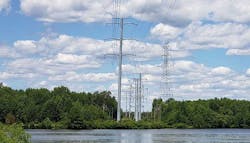Amid Rising Power Prices, AEP Expects 15 GW of New Data Center Capacity Growth Through 2030
American Electric Power (AEP) is the latest among U.S. utilities to acknowledge that coming data center growth is challenging the traditional power grid dynamic in historic ways.
During its second-quarter earnings webcast on July 30, AEP Interim CEO Ben Fowke told analysts that the utility has 15 GW of new and incremental load commitment from incoming data center customers through the end of this decade.
To put it in perspective, Fowke noted, AEP’s entire systemwide peak load was 35 GW at the end of 2023.
In other words, near-term and committed data center load growth in the AEP service territories would raise its load profile by more than 40% in six years.
Most of the newly committed data center customers will be located in Ohio and Texas, company leaders noted.
“These are far from just inquiries: These are serious customers that want to get on the grid and are willing to financially commit to doing what it takes to get on the grid,” Fowkes said during the earnings call with analysts and media. “This is more growth than maybe we’ve seen in a generation.”
The Race to Alternative Power
The data center industry, utilities and other energy partners are accelerating consideration of microgrids and other means of alternative power generation such as nuclear energy to meet the exponential expansion of cloud-based capacity and artificial intelligence in coming years.
Virginia-based Dominion Energy, for one, expects to connect some 15 new data centers into its system this year, representing close to 1 GW of load addition just within its service territory, according to its 2023 annual report.
Significantly, Dominion is also exploring the possibility of connecting a data center directly to a nuclear plant in Connecticut, the company said in its quarterly earnings call. ("We continue to explore that option,” CEO Robert Blue told analysts. “We realize any co-location option is going to have to make sense for us, our potential counterparty and stakeholders in Connecticut.)
Also in July, Dominion and Virginia Governor Glenn Youngkin announced a "moonshot" initiative to build a small modular nuclear reactor in the state, known for supporting the world's largest data market in Ashburn's Data Center Alley. Projected to deploy after 2030, if completed the SMR would the first such commercial facility in the U.S.
In June, the U.S. Department of Energy announced $2.7 billion From President Biden’s 'Investing in America' agenda to boost the U.S. domestic nuclear fuel supply chain.
Data Centers First In Line for Power Opportunities
The interconnections involved in adding utility power loads are complicated, time consuming and expensive. For its part, AEP said expects to invest about $43 billion in capital projects through 2028, including some $9 billion of that, or 22%, allocated for renewable energy within its regulated businesses.
The rest is divided among transmission, distribution and generation investment. New transmission, generation and distribution projects will involve new tariffs and rate structures, which could impact all customers.
The data centers under commitment, however, have signed letters of agreement in which they help pay for preliminary work on the power delivery projects.
“We continue to work with our data center customers to meet their increased demand,” the company said. “In the fall, we will provide an update on what the large load opportunities do to the capital spend.”
Meanwhile, on the flip side of anticipation for data center nuclear energy, it should be noted that AEP and Exelon have filed a challenge with the Federal Energy Regulatory Commission to challenge a Pennsylvania data center agreement which is co-locating a planned Amazon Web Services site developed by Cumulus and directly connecting it with the Susquehanna, Penn., nuclear power plant.
The AEP-Exelon challenge alleges the Cumulus-AWS agreement places an unfair cost on ratepayers.
In addition to the data center load growth in its Ohio and Texas territories, AEP said it also expects to finalize new or modified tariffs for future data center interconnection projects in Ohio, Indiana and West Virginia.
AEP said it has also been working on microgrid projects for 10 years. In 2023, it contracted power management firm Eaton to deliver a solar-storage microgrid for the city of Colombus, Ohio’s Tussing Water Booster Station.
Wholesale Power Prices Spike
In related news this week, Utility Dive reported that wholesale power prices for new capacity spiked higher in an auction this week at the PJM Interconnection, which serves the Northeast, including Dominion and Northern Virginia.
About two-thirds of the new capacity is reportedly sourced from fossil fuels, with nuclear at 21% and wind, solar and hydro at 7%.
Prices in the PJM Interconnection’s latest capacity auction reportedly hit record highs, which should provide incentives for power plant companies to build new generating resources as they keep existing ones operating, said the grid operator.
How much resource constraints in complex energy markets will continue to impact pricing is definitely a trend to watch.
Analysts say strong demand from data centers are among the reasons for the current price spike, along with generation plant retirements and grid planning snafus.
About the Author

Rod Walton
Rod Walton is Managing Editor of Endeavor Business Media's Microgrid Knowledge and EnergyTech, publications focused on the sustainability and resiliency goals of mission-critical and large-scale energy users, including the commercial and industrial sectors, as well as the military, universities and data centers.
Matt Vincent
A B2B technology journalist and editor with more than two decades of experience, Matt Vincent is Editor in Chief of Data Center Frontier.



